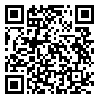BibTeX | RIS | EndNote | Medlars | ProCite | Reference Manager | RefWorks
Send citation to:
URL: http://jdisabilstud.org/article-1-1772-en.html
Background & Objectives: Learning disorders are the most common neurodevelopmental disorders. They have complex etiological aspects and individual variability. Learning disorder is a general term for a heterogeneous group of disorders manifested by significant problems in learning and using hearing, speaking, reading, writing, reasoning, or mathematical abilities. Reading disorder is undoubtedly one of the most important learning disorders. Characteristics of this disorder include the inability to recognize words accurately or express them fluently, or understand them. Along with reading problems, written speech problems are also found in most cases of learning disabilities. The process of transferring thoughts onto paper is called writing. Written expression is one of the most sophisticated skills needed to convey linguistic understanding and express thoughts and opinions. This research aimed to examine the effectiveness of Fernald's multi–sensory approach in improving dictation disorder and reading problems in students with learning disabilities.
Methods: The present research was an applied study in terms of purpose and a quasi–experimental study with a pretest–posttest design and a control group in terms of methodology. The study population consisted of all sixth–grade male students with learning disabilities studying in elementary schools of Semnan City, Iran, during the academic year of 2018–2019. After identifying 20 students from the two sixth grade classes, we tested them with the Student Identification Checklist for Learning Disabilities in Spelling (Agha–Babaei et al., 2011) and then analyzed and interpreted the scores. Next, 14 volunteer samples were purposefully selected based on the inclusion criteria (having dictation disorder, lacking mental and physical disorders, providing parental consent to participate in the study, and commitment to adherence to group rules). Finally, they were randomly divided into a control group and an experimental group. The sample size for each group was seven. The experimental group participated in 10 training sessions based on Fernald's multi–sensory approach, and the control group did not receive any intervention. Research data were collected using the Student Identification Checklist for Learning Disabilities in Spelling (Agha–Babaei et al., 2011), Reading Level Diagnostic Test (Azizian & Abedi, 2006), and Colorado Learning Difficulties Questionnaire (Willcutt et al., 2011). The collected data were analyzed at two levels of descriptive statistics (mean and standard deviation) and inferential statistics (multivariate analysis of covariance) in SPSS software version 25 at a significance level of 0.05.
Results: Findings showed that training sessions based on Fernald's multi–sensory approach could make a significant difference between two groups in dictation (p<0.005) and reading (p<0.005) variables. Based on the effect size, 79.4% of the change in dictation disorder scores and 48% of the change in reading difficulty scores were due to the intervention with Fernald's multi–sensory approach.
Conclusion: Based on the findings of this study, Fernald's multi–sensory approach effectively improves dictation disorder and reading problems of students with learning disabilities. The findings emphasized the efficacy of this approach in improving the educational status of students with learning disabilities.
| Rights and permissions | |
 |
This work is licensed under a Creative Commons Attribution-NonCommercial 4.0 International License. |





